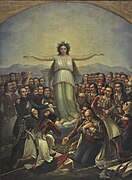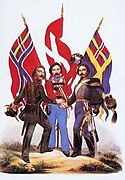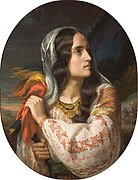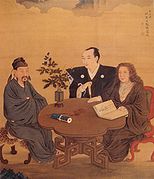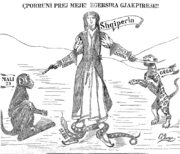National personification
This article needs additional citations for verification. (May 2012) |

A national personification is an anthropomorphism of a nation or its people; it can appear in both editorial cartoons and propaganda.
Some early personifications in the Western world tended to be national manifestations of the majestic wisdom and war goddess Minerva/Athena, and often took the Latin name of the ancient Roman province. Examples of this type include Britannia, Germania, Hibernia, Helvetia and Polonia. Representations of the everyman or citizenry—rather than of the nation itself—are Deutscher Michel and John Bull.[1]
A national personification is not the same as a national animal, although in some cartoons the national animal rather than the human personification is used to represent a country.
Personifications by country or territory
Gallery
-
1914 poster showing Marianne, Mother Russia and Britannia, the "Triple Entente" allies in the first World War (1914)..
-
Columbia, personification of the United States (World War I patriotic poster)
-
French Marianne « Freedom for France, freedom for the French » (1940).
-
Eugène Delacroix, Greece Expiring on the Ruins of Missolonghi (1827)
-
Theodoros Vryzakis' depiction of Hellas as a woman surrounded by rebels of the Greek War of Independence
-
España y Filipinas, 1886 painting by Juan Luna. Depicts the reformist view of the relationship between the Philippines and "Mother Spain"
-
Norway, Denmark and Sweden joining hands in a 19th Century poster
-
Lech, Czech, Rus and the White Eagle
-
World War I recruiting poster featuring John Bull.
-
Brazilian Constitutionalist Revolution recruiting poster, showing a Bandeirante with the dictator of Brazil, Getúlio Vargas, in his hand.
-
Allegory drawing depicting the friendship between the Argentine Republic and the newly formed Brazilian Republic.
-
Zé Povinho, caricature of a Portuguese working class man of the 19th century
-
In this 1806 French print, the woman with the Menorah represents the Jews being emancipated by Napoleon Bonaparte
-
James Gillray's cartoon on the 1803 Peace of Amiens, features a fat and non-martial Britannia kissing "Citizen François", a personifiaction of Revolutionary France
-
Romania Breaking off Her Chains on the Field of Liberty, also by C. D. Rosenthal
-
A later depiction of Romania as a helpless woman threatened by the brutal Germany in a World War I French caricature
-
The figures in this late 18th century painting by Shiba Kōkan represent Japan, China, and the West.
-
Columbia, America personified as a young woman holding up a Phrygian cap on a clipper ship card of the Young America Movement
-
Lady of the mountain in Iceland.
-
Peru (left), Argentina (centre) and Chile (right), personified at the Mausoleum of General San Martín, Buenos Aires.
-
Free Bulgaria; lithography by Georgi Danchov
-
17th century map by Frederik de Wit showing mythological Europa as the continent's personification
-
"Mrs. Britannia" and her daughter "Miss Canada" discussing "Cousin Jonathan"(the US) in an 1886 political cartoon.
-
John Bull, a national personification of the United Kingdom holds the head of Napoleon I of France in an 1803 caricature by James Gillray.
-
Albanian caricature from 1913 shows Albania as a woman defending herself from beasts representing neighboring countries seeking at the time to divide Albania's territory between them: Montenegro (monkey), Greece (leopard) and Serbia (snake), saying: "Get away from me! Bloodsucking beasts!"
-
The woman on the right, holding out a letter of thanks to the enthroned Jonathan Swift, represents Ireland (from the 1735 edition of Swift's works).
-
Bavaria, an early 19th-century statue made when Bavaria was a fully sovereign Kingdom with a considerable national pride
-
Political cartoon depicting the tangled web of European alliances.
-
In this Belarusian caricature commenting on the 1921 Peace of Riga, Russian Bolsheviks (to the right) and Nationalist Poles (on the left) are dividing the territory of Belarus.
See also
- Mural crown
- National emblem for other metaphors for nations
- Hetalia, a popular Japanese webcomic/manga/anime based on original personifications of countries created by Hidekaz Himaruya
References
- ^ Eric Hobsbawm, "Mass-Producing Traditions: Europe, 1870-1914," in Eric Hobsbawm and Terence Ranger, eds., The Invention of Tradition (Cambridge, 1983), 263-307.
- ^ O'Clery, M. (2003) Annals of Ireland by the Four Masters as translated into English
- ^ "A Manifesto from the Provisional Government of Macedonia". 1881.
Our mother Macedonia became now as a widow, lonely and deserted by her sons. She does not fly the banner of the victorious Macedonian army
{{cite journal}}: Cite journal requires|journal=(help) - ^ Bulgarian graphic representation of Bulgaria, East Rumelia and Macedonia
Lionel Gossman. "Making of a Romantic Icon: The Religious Context of Friedrich Overbeck's 'Italia und Germania.'" American Philosophical Society, 2007. ISBN 0-87169-975-3. [1]

















































